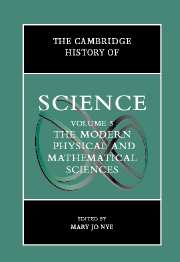Book contents
- Frontmatter
- Introduction: The Modern Physical and Mathematical Sciences
- Part I The Public Cultures of the Physical Sciences After 1800
- Part II Discipline Building in the Sciences: Places, Instruments, Communication
- Part III Chemistry and Physics: Problems Through the Early 1900s
- Part IV Atomic and Molecular Sciences in the Twentieth Century
- Part V Mathematics, Astronomy, and Cosmology Since the Eighteenth Century
- 23 The Geometrical Tradition: Mathematics, Space, and Reason in the Nineteenth Century
- 24 Between Rigor and Applications: Developments in the Concept of Function in Mathematical Analysis
- 25 Statistics and Physical Theories
- 26 Solar Science and Astrophysics
- 27 Cosmologies and Cosmogonies of Space and Time
- 28 The Physics and Chemistry of the Earth
- Part VI Problems and Promises at the End of the Twentieth Century
- Index
- References
23 - The Geometrical Tradition: Mathematics, Space, and Reason in the Nineteenth Century
from Part V - Mathematics, Astronomy, and Cosmology Since the Eighteenth Century
Published online by Cambridge University Press: 28 March 2008
- Frontmatter
- Introduction: The Modern Physical and Mathematical Sciences
- Part I The Public Cultures of the Physical Sciences After 1800
- Part II Discipline Building in the Sciences: Places, Instruments, Communication
- Part III Chemistry and Physics: Problems Through the Early 1900s
- Part IV Atomic and Molecular Sciences in the Twentieth Century
- Part V Mathematics, Astronomy, and Cosmology Since the Eighteenth Century
- 23 The Geometrical Tradition: Mathematics, Space, and Reason in the Nineteenth Century
- 24 Between Rigor and Applications: Developments in the Concept of Function in Mathematical Analysis
- 25 Statistics and Physical Theories
- 26 Solar Science and Astrophysics
- 27 Cosmologies and Cosmogonies of Space and Time
- 28 The Physics and Chemistry of the Earth
- Part VI Problems and Promises at the End of the Twentieth Century
- Index
- References
Summary
Until the end of the nineteenth century, geometry was the study of space. As such, geometrical knowledge can be found in virtually all civilizations. Ancient Sumerians, Babylonians, Chinese, Indians, Aztecs, and Egyptians surveyed their lands, constructed their pyramids, and knew the relation among the sides of a right triangle. The Western geometrical tradition dates from Euclid’s (fl. 295 B.C.E.) Elements. What marks this work as seminal lies not so much in its content per se as in how that content was known.
Two tightly interwoven characteristics marked Euclidean geometrical knowledge. First, the objective characteristic was the strict correspondence between the terms of the geometry and the objects to which those terms referred. Euclid’s geometry dealt with something that we would call space. For example, the Euclidean definition “a point is that which has no part” neither explains the concept of point nor shows how to use it nor establishes its existence. It does, however, indicate what a point is. The definition has meaning; it refers to an aspect of space that we already know.
Euclidean axioms are self–evident truths; the postulates are obvious statements that must be accepted before the rest can follow. Like the definitions, the axioms and postulates are statements about space that make explicit what we already know. Euclid’s axioms and postulates do more, however. They support and structure all of the subsequent argument; all of the rest of the subject is drawn out of or built upon these basics. The adequacy of this axiomatic structure to support all legitimate geometrical conclusions is the second, rational, characteristic of Euclidean knowledge.
- Type
- Chapter
- Information
- The Cambridge History of Science , pp. 447 - 467Publisher: Cambridge University PressPrint publication year: 2002



